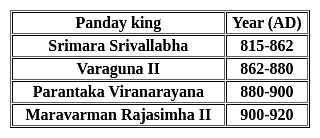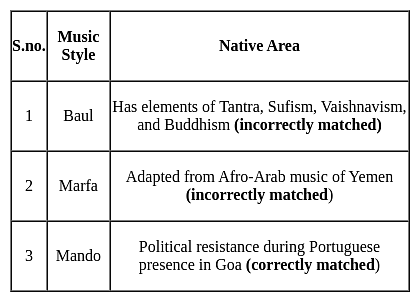UGC NET Paper 2 History Mock Test - 5 - UGC NET MCQ
30 Questions MCQ Test UGC NET Mock Test Series 2024 - UGC NET Paper 2 History Mock Test - 5
The capital was shifted from Anmakonda to Orugallu during the regime of this king
Which of the following Pandya king take help from Sri Lankan king Kassapa-V against Cholas in the battle of Velur.
Where of the following the second Sangam was organized?
With reference to Jainism, consider the following statements:
1. Mahavira was a Kshatriya prince of the Lichchhavis
2. Mahavira taught in the Prakrit language.
3. Jainism was supported by all sections of society.
4. The basic philosophy of Jainism was written after the demise of Mahavira.
Which of the following statements given above are correct?
Consider the following pairs:
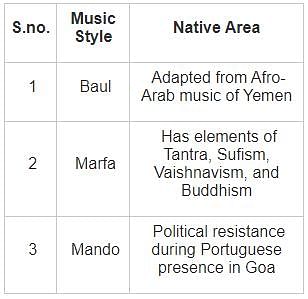
Which of the above pairs is/are correctly matched?
Match the following and choose the correct option:
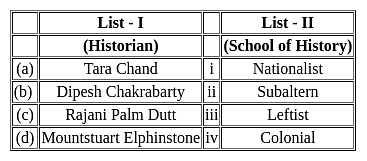
Which of the following is not correctly matched?
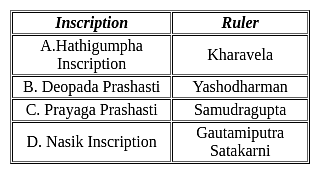
Which of the following statements is/are correct regarding the Swadeshi and Boycott Movement?
1. It was termed as a befitting reply for the Partition of Bengal.
2. Mass meetings were held all over Bengal where Swadeshi or use of Indian goods and boycott of British goods.
3. The Swadesi movement gave a great deal of encouragement to Indian industries.
4. Acharya P.C. Ray organised his famous Bengal Chemical Swadeshi Stores.
Consider the following statement regarding Ashoka's Dhamma:
1. The theme of ahimsa is an important aspect of Ashoka's dhamma and is frequently mentioned.
2. The ceremony of the dhamma is described as consisting of proper courtesy to slaves and servants, respectful behavior towards elders, and liberality to sharmanas and Brahmanas.
3. Major Rock Edict I declares prohibition of animal sacrifice and holiday of festive gatherings.
How many of the above statements are correct?
Choose the reason/reasons behind the commercialization of agriculture during British rule :
1. India was reduced to a supplier of raw materials.
2. Better means of transportation made trade-in agro products feasible.
3. Monetization of land revenue payment.
4. Industrial Revolution in England.
Choose the correct option :
Which of the following statements about Mohiniattam is/are correct?
1) It is one of the important dance form of Kerala.
2) It is a solo dance performance that incorporates lasya and tandava styles.
3) It is a technique based on Kathakali.
Codes:
With reference to Ryotwari Settlement, consider the following statements:
1) The rent was paid directly by the peasants to the Government.
2) The Government gave Pattas to the Ryots.
3) The lands were surveyed and assessed before being taxed.
Which of the statements given above is/are correct?
Why was Subsidiary Alliance system considered as Trojan horse tactic?
Consider the following pairs:
1) Muzzafarpur Conspiracy Case:- Aurobindo Ghosh and Barinda Kumar Ghosh
2) Alipur Conspiracy Case:- Khudiram Bose and Prafulla Chaki
3) Kakori Conspiracy:- Ram Prasad Bismil, Ashfaqulla Khan
Choose the incorrect pair.
Which strategies were employed for the integration of princely states into the Indian Union?
- Diplomacy
- Persuasion
- Military intervention
- Plebiscite
Match List-I with List-II and select the correct answer using the codes given below the lists:
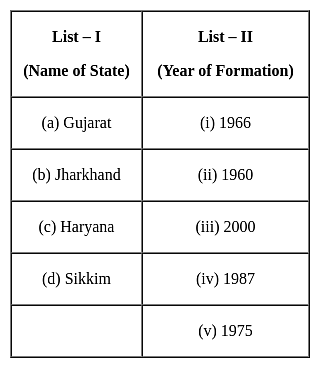
Mahabalipuram was a port city of which of the following dynasties?
Rebellion among the naval ratings in RIN (Royal Indian Navy) started IN 1946 from which of the below places?
Which of the following Nizam of Hyderabad secured the protection of French General Bussy in 18th century to protect his territories?
What made Jahangir issue a farman in 1613 permitting the English to establish a factory permanently in Surat?
Consider the following Maratha Powers with treaties which they had with British:
- Peshwa – Treaty of Bassein
- Bhonsle – Treaty of Deogaon
- Sindhia – Treaty of Surji Anjangaon
Which of the above is/are correct?
What was the primary objective of the East India Company in India?
The Regulating Act was passed in which year?
|
16 docs|120 tests
|


